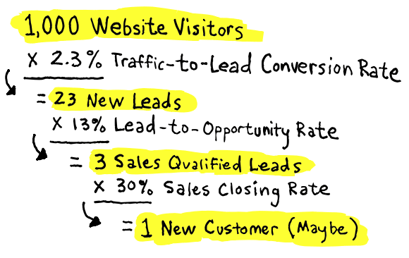
Let’s talk about the status quo in B2B marketing - more is more. Will that get us to the goal line or is it time for a pivot?
Even though it’s the status quo, the idea that more traffic and more leads consistently drive revenue growth has been under attack for some time now. Many companies have changed direction, focusing on “account-based” or “product-led” strategies. While not necessarily new ideas, these approaches concentrate on a shortlist of ideal customers and the post-conversion customer experience to drive growth. But what’s wrong with the old playbook?
The problem with the “more is more” philosophy in both inbound and outbound marketing is that more is never enough, and more can actually hurt your ability to attract and convert leads into sales.
More is Never Enough
The average landing page conversion rate for B2B was 2.3%, according to Wordstream. While some industries do better than others, and the top 25% of companies convert at closer to 5%, it’s still a struggle to generate leads for B2B marketers. Let’s do the math. At a 2.3% conversion rate, you need 1000 landing page visits to generate 23 leads. Do your landing pages get that many visits and leads each month? What percentage of your overall website visitors even see your landing pages? Five percent? Ten percent? At 10%, you need an average of 10,000 website visits to generate 23 leads.

Now, let’s look at sales opportunities. How many of those leads you’ve converted become viable sales opportunities? Many are curious or interested in the content they downloaded or the webinar they attended. Did they really want to talk to a sales rep or schedule a demo? Were they qualified buyers with a high intent to purchase? The average lead-to-opportunity conversion rate is about 13%, according to Young Marketing. That means that of your twenty-three leads, only three will become opportunities, and maybe one will become a customer, depending on your sales closing rate. Don’t forget, all of this funnel math depends on how you define the various stages of the customer journey, for example, leads, MQLs, SQLs, SALs, Opps, and customers. Bottom line, the challenge is pretty daunting, considering the relatively low average conversion rates. A thousand website visits to get one customer - maybe!
Now think about growth. If your executive team says that they need 2X or even 5X growth in sales this year, well you do the math.
More Can Actually be Worse
Let’s assume that your inbound marketing and demand generation programs are firing on all cylinders, and you’re filling the funnel with inbound leads month over month. You’re hitting all of your goals for metrics like traffic, leads, and lead conversion rates. The next question is, are those leads qualified, and are they ready to buy?
If not, then you are asking your sales team to spend their time meeting with a large number of unqualified leads who end up wasting their time. This shows up in your lead-to-opportunity and lead-to-customer conversion rates and should be one of your KPIs. The problem is compounded when your sales team complains about the low-quality leads they are being handled by marketing, and the blame game starts to escalate. The net effect is that sales and marketing are not aligned, and company revenue goals are not being met.
Focus on Customers First
Let’s back up and identify the root cause of the problems above. Focusing on more traffic and more leads drives marketers to do anything they can to attract and capture those leads, regardless of lead quality, which is really about “fit” for your products and services and the “intent” to buy them. To increase lead volume, regardless of fit or intent, B2B marketers adjust their SEO & PPC strategies and lead conversion offers to attract a broad audience to gain more website visits and conversions. This approach typically increases traffic and leads, but it reduces the number of qualified buyers entering your pipeline - hence the term “vanity metrics” that is commonly applied to top-funnel KPIs.
A More Practical Alternative to More-is-More Marketing
Go back to marketing fundamentals and design your B2B marketing strategy to focus on finding, attracting, and converting qualified buyers.
- Find out who your best-fit, highest-value customers are using customer interviews, data you’ve collected, demographics, firmographics, intent data - anything you can to understand their “why”. Why did they choose you, and why are they great customers?
- Put this information together in an ideal customer profile that allows you to easily identify, target, and prioritize companies (and people) that you want as new customers.
- Design your customer acquisition strategy around attracting and starting conversations with your ideal customer profile target companies. This means aligning all of your SEO, paid media, content, and conversion offers around common themes and issues that your ideal customers share. It also means engaging directly with them, one-to-one on social media, but not in a “salesy” way. You want to build relationships, not capture sales leads.
- Share all engagement data and insights with your go-to-market teams. Sales, Marketing, and Customer Success should be working together as a team aligned on customer engagement and building trust, verified by shared KPIs.
- Measure and analyze KPIs that are relevant to company growth, rather than vanity metrics. Focus on sales-qualified opportunities (SQO) added to your pipeline each month, along with revenue, customer acquisition cost, net revenue retention, and account expansion. Redefine MORE to align with these metrics instead of traffic and leads.
What happens if you do this?
You will probably find that your vanity metrics decline because now you are concentrating on qualified buyers only, and you are seeking engagement rather than simple conversion. You will also find that your Sales team is happier because the leads that they receive are fewer but far more qualified and ready to buy. Their close rates go up, and their quotas are met more frequently. On the Customer Success side, they find that it is easier to work with new customers, retain them, and grow their accounts. In other words, everybody (including your customers) wins, and change can be a very good thing - if you commit to it.
So why not try something different? You don’t have to change everything overnight. Start by challenging your beliefs about traditional, volume-based marketing. Think about your customers as individuals and small groups with common interests. Figure out how to start more conversations with them and worry less about “conversions” and “captures”. Focus on helping them solve their problems and achieve their goals, but don’t be afraid to challenge their beliefs.
Let’s march forward together and help each other grow!









